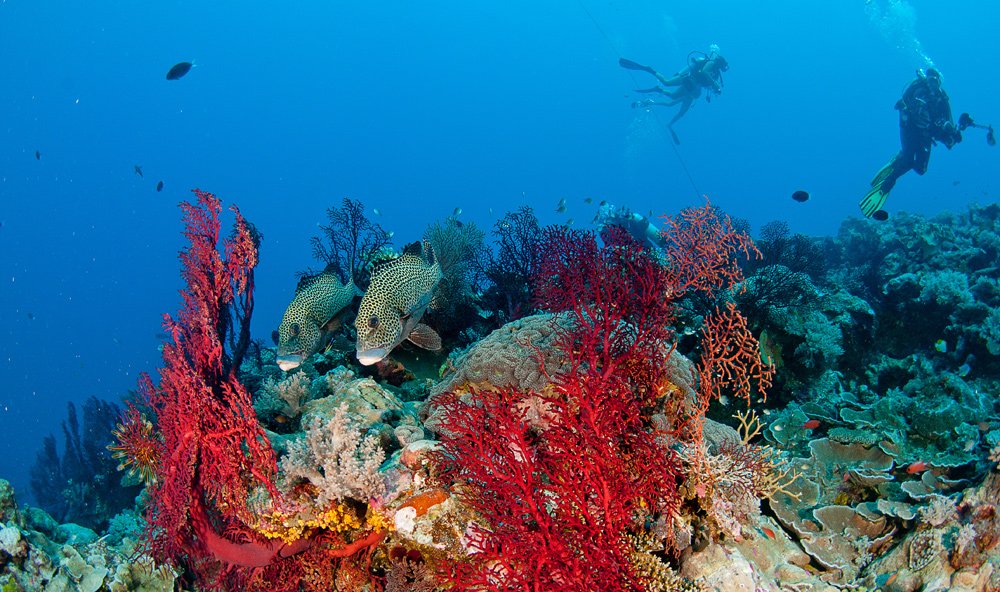Reefs of the Coral Sea
The reefs of Australia’s Coral Sea Marine Park are unique and extraordinarily diverse. Home to a colourful array of corals, fish and other wildlife, they are a rare example of a thriving wild marine environment protected by isolation from direct human impacts.
Did you know?
- Nearly 600 fish species were recently identified during the first ever comprehensive surveys of the reefs.
- 34 isolated reefs are scattered throughout the almost 1 million kilometres squared reserve.
- Only 1 per cent of the entire Coral Sea Marine Park is made up of reefs, but this still amounts to 15,024 square kilometres (three times the size of Bali).
A world of diversity
Located far offshore from Queensland, the line of Coral Sea reefs stretches from near Papua New Guinea down to just north of Fraser Island.
There are distinct habitat differences from north to south, and also a lot of variation from reef to reef.
“The animal and plant species we found were like nowhere else in Australia. We were amazed by the numbers of sea snakes and reef sharks that regularly accompanied us during our dives.”
~ Professor Graham Edgar, Reef Life Survey ~
The north has the richest collection of different reef fish.
Further south the reefs have denser coral cover, including delicate branching corals, and more coral-dependent species such as butterfly fish.
A rich place for reef research and discovery
The reefs were first comprehensively explored in 2012 and 2013, when dive teams from Reef Life Survey studied and recorded species and reef communities at 17 reefs.
They found that Coral Sea reefs are the only locations in Australia with fish, crustaceans and clams typical of those found on oceanic Pacific islands.
Although only a few hundred kilometres from the Great Barrier Reef, Coral Sea reef animal communities are more similar to those of the oceanic islands and atolls of Tonga and Samoa, more than 2500 kilometres away.
Reef dwellers
The marine park contains hundreds of different species of hard and soft corals.
Encrusting corals are the most widespread and there are also spectacular displays of massive boulder-shaped corals.
The marine park is a globally significant hotspot for reef sharks but is also populated by reef fish in every imaginable size, shape and colour, as well as sponges, sea snakes, urchins, sea snails, starfish and clams.
Reef visitors
Predator fish like tuna, broadbill swordfish, marlin and sharks patrol the area.
The reefs are also important mating and feeding grounds for tiger sharks and are used by sea turtles for migration stopovers and nesting on islands and cays.
Explore it for yourself
A journey to the reefs of the Coral Sea provides visitors with an experience like no other, with excellent visibility and different reef structures and species to the neighbouring Great Barrier Reef.
Because the area is so remote, Coral Sea live-aboard expeditions are the main way to visit. Many expeditions also stop in the Great Barrier Reef along the way.
Without a doubt it’s worth the long journey.
The reefs have a wild, pristine beauty you won’t find anywhere else, along with extraordinary marine life and unparalleled diving, sailing and fishing.
Diving
 Red coral, fish and divers.
Red coral, fish and divers.
With crystal-clear waters providing exceptional visibility (30–60 metres) the Coral Sea offers some of the most amazing diving in the world. Standout destinations include:
- Osprey Reef for spectacular shark sightings and all-round stunning diving on coral walls
- Holmes Reef for huge, colourful plate corals
- Bougainville Reef for spectacular walls, drop-offs, close encounters with potato cod and fish species rarely seen elsewhere in Australia.
Discover more
Find out about:
- the Coral Sea Marine Park, including its reefs
- the Reef Life Survey
- Osprey Reef
- visiting the Coral Sea.
Learn about your marine parks
Stay in touch
Subscribe to receive important updates about your marine parks. Enter your email address and click "join now".








